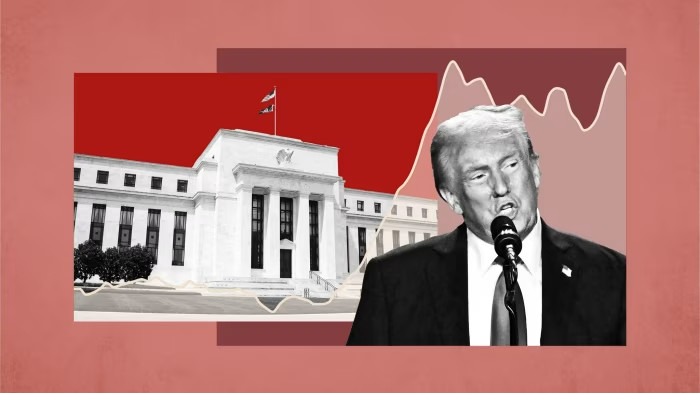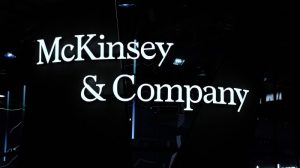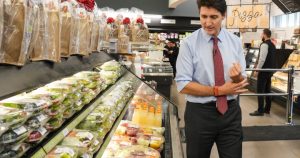Tariffs and taxes are not very inflationary

This article is an on-site version of our Chris Giles on Central Banks newsletter. Premium subscribers can sign up here to get the newsletter delivered every Tuesday. Standard subscribers can upgrade to Premium here, or explore all FT newsletters
Raghuram Rajan, the University of Chicago professor and former Reserve Bank of India governor, will receive the Bancor award in economics today. In his bleak acceptance speech, he notes the world economy is “fragmenting slowly, but surely” and says much of this stems from “misdirected anger at trade” when the big job killer in the US has been technology, not foreigners.
Perhaps most telling is the following passage:
After this gloomy assessment, in typical speeches the speaker pulls out their magic solutions to all the problems that envelop us. Unfortunately, I have none.
President-elect Donald Trump has certainly stoked anger in the US about trade. It is in many ways odd that the US is most unhappy with trade because it is an extremely closed economy, as the chart below shows.
Large economies will generally be more closed to external trade than smaller ones (hence the EU and Eurozone are more closed than individual member states), but the US is in a league of its own compared with the EU, China and India. None of this will matter. Tariffs are coming.
The questions are who will pay, and are tariffs inflationary?
In the US presidential election, the effects of tariffs caused little academic disagreement. About 95 per cent of economists polled by the Kent Clark Center for Global Markets in September agreed or strongly agreed with the statement that “imposing tariffs results in a substantial portion of the tariffs being borne by consumers of the country that enacts the tariffs”.
This consensus did not extinguish all debate. In a remarkable online argument, Oren Cass, the chief economist of American Compass, fought toe-to-toe with Justin Wolfers, a professor at the University of Michigan, over just this issue and, in particular, the chart reproduced below. Cass accused Wolfers of being simplistic in attributing relative price changes to tariffs and accused him of cherry-picking data.
The common sense way to look at the chart is to say — as Wolfers did — that the 20 to 50 per cent tariffs on imported washing machines between 2018 and 2023 raised consumer prices compared with other appliances where no tariff was applied. There is a difficult period for this argument, between mid-2019 and mid-2020, but this should not invalidate the position that US tariffs were borne by the US.
So far, the points have been anecdotal and we really need a more comprehensive account. Theoretically, Trump is not necessarily wrong to say that the foreign exporter might bear the burden of tariffs, so the outcome is an empirical issue.
There are many worthy academic studies of the Trump tariffs from 2018. While not the most riveting reads, they give a reasonably clear account of the evidence. If you want to listen rather than read, try Soumaya Keynes’ podcast this week with Kimberly Clausing. The evidence suggests:
-
US importers bore the vast majority of the cost of tariffs. Overall, for a 20 per cent tariff, the importer paid 18.9 per cent higher prices with the ex-tariff price reducing just 1.1 per cent. Tariffs were passed on to US importers much more than US exchange rate depreciations, where contracts tend to be fixed for a period in dollars.
-
The one exception from this rule was for steel tariffs, a commodity used as an intermediate good. Here, exporters to the US dropped prices substantially to remain competitive.
-
While US importers paid, these costs were not always passed on directly to US consumers. Washing machines were a bit of an exception where prices rose. In other areas, prices barely increased. It is less certain whether retailers spread the tariff effect over multiple goods, margins were squeezed or products were bought ahead of tariffs being imposed.
-
Retaliation with tariffs imposed on imports of US goods was often concentrated among homogenous agricultural products with many global suppliers. US producers had to reduce their export prices in response.
The incidence of US tariffs clearly appears to fall on the US corporate sector, with it then passed on to households in a combination of lower profits, higher prices and lower wages.
A new set of tariffs applied more aggressively, across the board and for longer can therefore be expected to have significant detrimental effects on the US, although we must remember that the country’s economy is relatively closed so these might not be huge.
The important point is that the evidence suggests the US overwhelmingly bears the costs, but exactly how these are passed to households remains rather murky. The inflation effect does not appear large.
OK, what about taxes?
British business leaders are angry with the new Labour government. The October 30 Budget raised the UK’s main payroll tax, employers’ national insurance contributions, from 13.8 per cent to 15 per cent from next April and reduced tax-free thresholds.
Sainsbury’s, the country’s second-largest supermarket chain, said the additional costs it and its suppliers faced would “feed through into higher inflation”. Saying much the same were companies including the grocery and clothing retailer Marks and Spencer, the telecoms company BT and the pub group Wetherspoons. Today, retailers have clubbed together to send a joint letter of complaint to the chancellor.
In response, chancellor Rachel Reeves has sought to flatter. Companies can absorb the new tax worth almost 1 per cent of GDP with greater efficiencies or lower profits, she says. “Businesses are amazingly creative and have great ingenuity, and one of the things that they do really well is drive efficiency and productivity performance,” she told MPs in a parliamentary hearing.
Just like tariffs, the likely outcome is an empirical question. The natural places for the tax to end up are in lower wages, lower profits or higher prices.
There is pretty good evidence from the past. In the 2010s, employers were forced to contribute to their employees’ defined contribution pensions in an auto-enrolment scheme, where the vast majority of employees participated. As the chart below shows, it is not easy to see an impact of the 1 per cent, 2 per cent and 3 per cent compulsory contribution levels on trends in nominal wage growth or inflation. Perhaps there was an effect in 2012, but this was much smaller than the obvious exchange-rate impact on prices that caused the sterling’s plunge after the 2016 Brexit referendum.
Luckily, we do not have to rely on seeking a signal in the noise of macro data because the UK’s independent Office for Budget Responsibility has examined the evidence.
In a glorious moment of candour, professor David Miles, one of the OBR’s leading officials, told members of parliament that the fiscal watchdog had examined a “quite big, very boring, academic literature” on the subject of who pays. It had come to “central” estimates, “based on hundreds of boring studies”. You can feel his pain.
Using the results of this tedious effort, the OBR has estimated that in the first year of operation, 40 per cent of the cost of higher employer NICs will hit profits, with 60 per cent being borne by households in the form of lower wages and higher prices. After that, the incidence of the tax increase is borne more by households with the split ending up as 76 per cent in lower real wages and 24 per cent in lower profits. The OBR does not assume (correctly) that companies become more efficient as a result of the tax — they already have an incentive to cut unnecessary costs.
Only 20 per cent of the effect on real wages is expected to come through higher prices, the OBR estimated. A fifth of the 76 per cent of total annual revenue from the tax increase of £25bn suggests £3.8bn of the money raised would result in a rise in nominal prices. With consumer spending of roughly £1.65tn in 2023, it suggests a one-off price impact of 0.2 per cent, but spread over a period longer than a year. This is precisely the effect the OBR has assumed.
The Bank of England has assumed much the same in the chart below. The direct effect of the employer NICs increase on inflation in any one annual period (only mentioned in a chart footnote) was about 0.1 per cent, and included in the “other Budget effects” category which also counted rises in bus fares, higher car taxes and value added tax on private school fees. The exact number is impossible to glean from BoE documents.
UK companies are justified in feeling angry since they have the hassle of passing a new tax on to shareholders, customers and employees. It is probably best to ignore them, however, when they say the move was inflationary.
Lots of boring studies suggest otherwise.
What I’ve been reading and watching
A chart that matters
With Trump having made multiple threats to the Fed’s independence, it is a good time to look at a remarkable chart that documents the formal spread of central bank independence compiled by my colleague Joel Suss. Although legal independence appears secure, it is gradually being undermined in practice in many countries. Click on the chart to see the full measures of independence.
Recommended newsletters for you
Free lunch — Your guide to the global economic policy debate. Sign up here
Trade Secrets — A must-read on the changing face of international trade and globalisation. Sign up here
#Tariffs #taxes #inflationary










